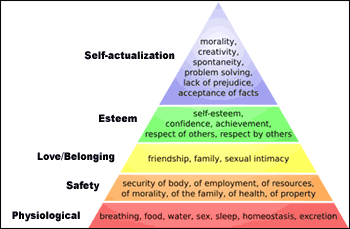Tip #1: Put the call to action in front
In just about every content presentation I've given, a good third of my time is spent talking about how to best use text to "sell" a message on digital signs. And perhaps the most important use of text is in creating an effective call to action. A call to action (CTA) is exactly what it sounds like -- an imperative statement that calls upon the viewer to take some action. It could be as simple as "buy me today!" or "drop keys here for self-checkout". Or, it can be a bit more complex and subtle, like "give the gift of financial security" (in a life insurance spot, for example), or "are you ready for hurricane season?" (down here in South Florida, that's more of a rhetorical question).
Tip #2: Throw down the gauntlet and offer your viewers a challenge
We've written about best practices for crafting an effective call to action a number of times, so I won't go into all of that detail again. However, tying it back to the FMOT concept, a call to action can be like a statement or reckoning too. Challenging your viewers with a slightly in-your-face command statement is a great way to engage them -- as long as it comes across as edgy and not obnoxious, anyway. The neat thing about a challenge is that it's a more positive way to establish a moment of truth than a simple command. For example, a CTA for a weight loss drug like "ImagiBurn helped me lose 75 lbs. Find out what it can do for you", is going to be more positive and compelling than "Find out what ImagiBurn can do for you" by itself, because it challenges the viewer to make a comparison and then take an action. Yes, it's a bit on the long side for a CTA, although you might consider the first sentence to just be a lead-in. But establishing a positive FMOT can take a bit more setup than a simple CTA normally allows.
Tip #3: Pick the "right" emotional appeal

It's a bit of an Internet cliche to pull out Maslow's hierarchy of needs, I know. And maybe next time I'll talk about Jung's archetypes, or really go crazy and drop some Foucault. But if you want to make a quick connection with an anonymous audience, you could do worse than to target those areas that are probably most pressing on their minds. For example, in an ER it's a safe bet that people are going to be thinking about their physical well-being, so messages targeting physiological and safety needs might play well. In a cosmetic surgeon's waiting room, on the other hand, targeting belonging and esteem needs might be more effective.
Similarly, on the plant floor safety always reigns supreme. But instead of targeting safety needs outright, it might be more effective to develop messaging focused on employees' belonging needs in an effort to develop a sense of "togetherness" that could contribute to improved employee safety. Likewise, targeting employee self-actualization needs is a practical way to impart a feeling of appreciation that again can have an effect on everything from morale to safety.
Tip #4: Use power words
No matter what language you (and your viewers) speak, there will be certain words that can create an instant and compelling psychological force. Much like viewers can't help but look at attention vampires, words like "danger", "free" and even "now" can measurably affect viewer behavior. There are plenty of lists of so-called power words out there on the Internet, and not having tested them, I couldn't tell you which are really the best. But run a few web searches and I'm sure you will find some evidence of certain words and phrases that tend to come up again and again in a context similar to your own.
Tip #5: Repeat, repeat, repeat
Last but not least, don't be afraid to repeat yourself. Repetition is another one of the mnemonic devices we talk about in our series on making great digital signage content. But in a FMOT context, repetition should extend past a single clip running on your screens, to preferably encompass every clip. And if your audience is likely to see your screens several days in a row (like in a hotel lobby) or potentially every day (like in an employee break room), repetition should ideally span these multi-day periods as well. Saying the same thing over and over can be effective -- but also off-puttingly boring. So whenever possible, add some variation to keep the content unique and interesting.
There you have it: five practical, actionable tips for improving the performance of your digital messaging.
Do you have any other tips for making a connection with an audience? Leave a comment and let us know about them!

 Subscribe to the Digital Signage Insider RSS feed
Subscribe to the Digital Signage Insider RSS feed